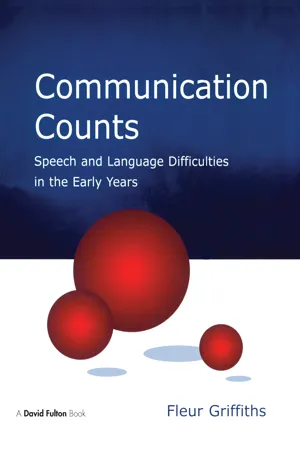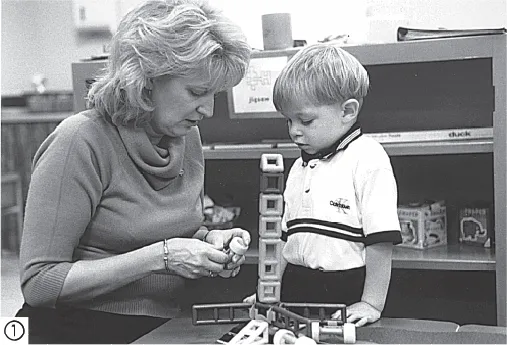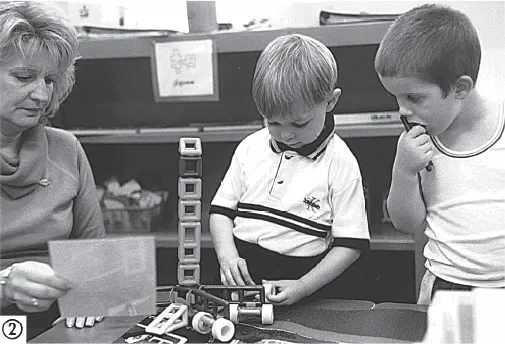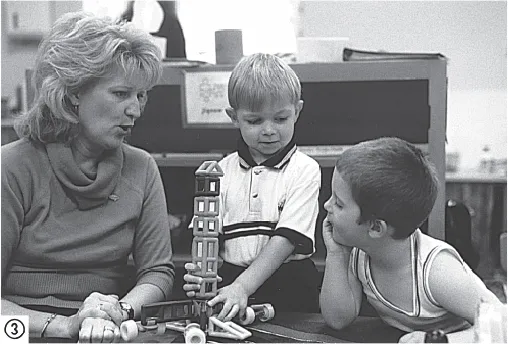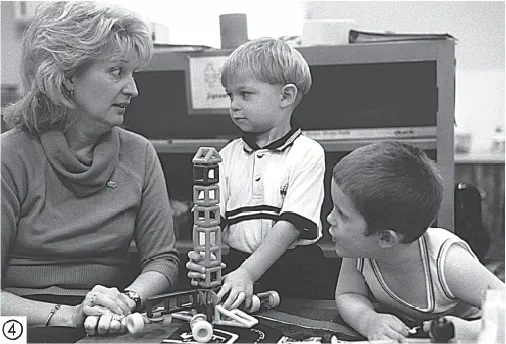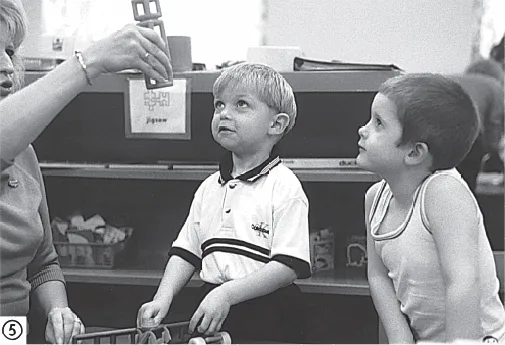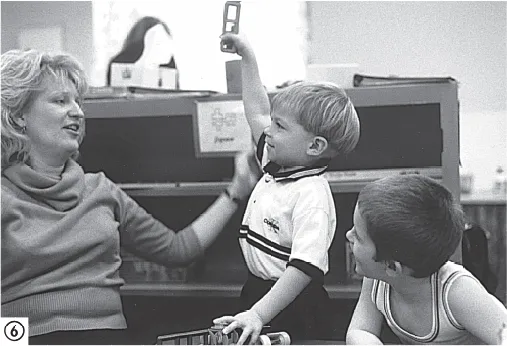![]()
CHAPTER 1
Being a Play Partner
(Griffiths 2000: 75–6)
I open with this story which has been the most memorable part of an article I wrote about being a play partner with children with communication difficulties (Griffiths 2000). Such is the power of story! It arose in response to a question in a parents’ support group session. A father was seeking advice about what to do about his son, who would not engage with the speech and language tasks set as homework. Instead, the child had withdrawn into a stubborn, sullen silence and could not be moved from an everlasting preoccupation with pulling trains around and around the track. All this father wanted was to have a conversation with him but tried in vain. Rather than give suggestions and solutions, I simply countered with this account of a recent visit to a mainstream nursery. Since more can be gained from parable than precept, I left the story to speak for itself. The father reported some weeks later that he was enjoying making tracks and playing trains with his lad and was on to other pastimes; he highly recommended the ‘train way’. This became a metaphor for being a play partner.
Taking turns to build a rocket.
I have not found a better explanation of what a play partner does than the following description, which I have kept with me since it was first published (see also Box 1.1):
In our work, however limited the child’s verbal contribution, we aim to become responsive play partners, concentrating on connecting with the child’s interests. Very often we retrace the development to the stage of non-verbal or proto-conversations, taking turns around a shared focus of attention. ‘My turn’ to scoop some sand on the turning wheel, and now it is ‘your turn’. I choose a puzzle piece and now ‘you choose’ a piece. You pick a red bead so I do the ‘same’ on my parallel string. I wait and watch you and then you stop to see what I do to match. Keep the doing of the action intact and then give pause to watch and listen. Keep the alternating sequence. Enjoy being a partner. Share the frown of concentration and the joy of achievement. Thus, eye contact happens and the effects of actions are jointly observed and celebrated. Agency is made clear and sociable. Quite often we need to go back to building and knocking down towers, crashing cars as well as fitting, fixing and mark-making together. Language is fused to the heat of these moments.
When on a first home visit, the items I bring are not test items which I administer, where the child performs (or doesn’t) and the parent watches (or butts in) and feels proud (or worried) by the result. The whole intention is to create contexts of mutual support which continue once I have left. All ‘toys’ are used socially. The family group (often including siblings and grandparents) joins in, taking turns around a shared activity. We play lotto, thread beads, complete jigsaws, match and sort but all as equal partners taking turns. The adults simply comment on their choices and needs as they fit with the joint endeavour. There is no need to direct, question, correct or set tests. I pick the ‘same as you’ and you take notice. Thus, the facilitative relationship of play partnering is modelled and practised from the outset. The adult, rather than feeling s/he is handing over to the expert professional, is realising the value of what often comes naturally to parents: responding to the pragmatic basis of communication rather than pursuing linguistic functions, divorced from contexts that make sense to the child. Parents are empowered to expand, comment, pour social oil, celebrate or clarify, rather than question and drill. They are responsible for keeping the interchange going, making timely repairs. They generally appreciate the story (once again the story works better than advice) I tell about myself as a young child; how I felt when my grammar was corrected instead of my message being received empathetically. Expecting to be praised for eating all my rice pudding ‘which I didn’t use to like’, I was corrected grammatically to ‘used not to’. We all remember how we felt being told to ‘Say please and thank you’. So often, children with communication difficulties are passive recipients of such instructions, rather than expressive selves.
Facilitative patterns of play are likely to be revisited in the home once the visitor has gone, and it is good if the children can recognise the same arrangements and routines in play at the nursery. Feeling familiar gives the children a sense of security in knowing the ropes and having an active part to play. Here is the pleasure of anticipation and participation with others. There is less chance of home and school speaking different languages and more likelihood of learning transferring from one context to another. Home and school are building up shared meanings around similar activities. If home visits are seen only as opportunities to pass on professional expertise, the transplant can well be rejected. If instead, dialogue and negotiation and solution-focused talk take precedence, a more powerful parental partnership model comes about.
Since parents tend to agree that what they most want is a conversation with their children, they are usually relieved to forgo a didactic role. To become play partners, conversing around joint activities takes the pressure from forcing linguistic exchanges and teaching prescribed lessons. It has been found (Anderson-Wood and Smith 1997: 13) that children who have missed the experience of reciprocal interaction with significant others benefit from ‘intensive interactive therapy’ of six to eight weeks. They present strong arguments for the priority of pragmatics assessment over other areas of speech and language therapy assessment since, developmentally, pragmatics precedes the acquisition of speech and language skills. These authors assert that it is not enough when helping such children to ‘equip them with knowledge of fixed meanings and syntactic constructions. They must learn to converse: to share negotiated meanings with others’ (ibid.). They point out that the success or failure of speech acts depends on how cooperatively the ‘communication-guessing game’ is played (ibid.: 8).
What can look like ‘just playing’ from the outside has a definite purpose and rationale underpinning such practice (Griffiths 2000: 72). It takes strength from the close analysis made of the to-and-fro pattern of early exchanges between infants and significant others (Trevarthen 1979), and puts joint meaning-making at the centre of language learning (Wells 1987). This turn-taking quality with its alternating of acting and observing around a topic resembles the roles of speaker and listener in regular conversation. Just as nursery rhymes allow shared events to be anticipated, so ‘games formats’ (Smith 1995) give a chance to focus jointly on an action, and have been shown to enable children on the autistic spectrum to become aware of other players. The actors in the game then share the same meanings and memories (Bruner 1983). Further games can centre on common events in children’s lives like shopping and cooking. Such events can be recalled with greater accuracy and it is known that children are more able to keep to the correct sequencing in the telling (Nelson 1985). They achieve better expressive competence because they have something important to communicate to someone who cares to listen and who can infer and flesh out intended meanings. Being understood makes the telling worthwhile.
Games have to involve the child and not be artificial constructs designed to teach linguistic concepts (see Mackay and Watson 1989). For example, children love to play hide and seek, to be lost and found, and this can be the motive that induces them to play. A parent well understood this when she was asked by professionals to concentrate on teaching ‘big and little’ and she chose to hide objects around the house: she and her son found pairs like a toothbrush and a floor brush; a ping-pong ball and a football. The size of the objects related to their real-life functions and big and little were therefore more readily absorbed. False scenarios, dressed up as a game where we all wait our turn to pick out items, make it very difficult to decide on relative concepts out of context. What is ‘little’ about a plastic calf in the farm set, when a real cow is so big, bigger than a boy? Why separate plastic animals from clothes unless you need to save the toys from a spin in the washing machine! A child, unable to sort clothes from animals, however many times he has been shown the task in the classroom, might have no difficulty separating buttons from smarties, similar in shape and size but functionally worlds apart. To know what is edible and what is not is a necessary judgement in life and a matter of pragmatic importance primarily. Trying to see through the eyes of the child and to converse with him is a very different matter from deciding what he should know and teaching it.
On another occasion, parents were unimpressed by a video of a semantic sorting ‘game’ which required six children in turn to respond to the teacher holding up an item of clothing or a plastic animal by indicating in which set/ring to place the object. Parents felt that the children looked bored and unmoved even by the clapping which greeted a right response. They felt that the activity had no meaning for the children. In contrast, the excitement of children playing together with a parachute was contagious and after the adults had played the same cooperative game, a grandparent commented about the children’s learning:
Parents could spot the difference bet...
